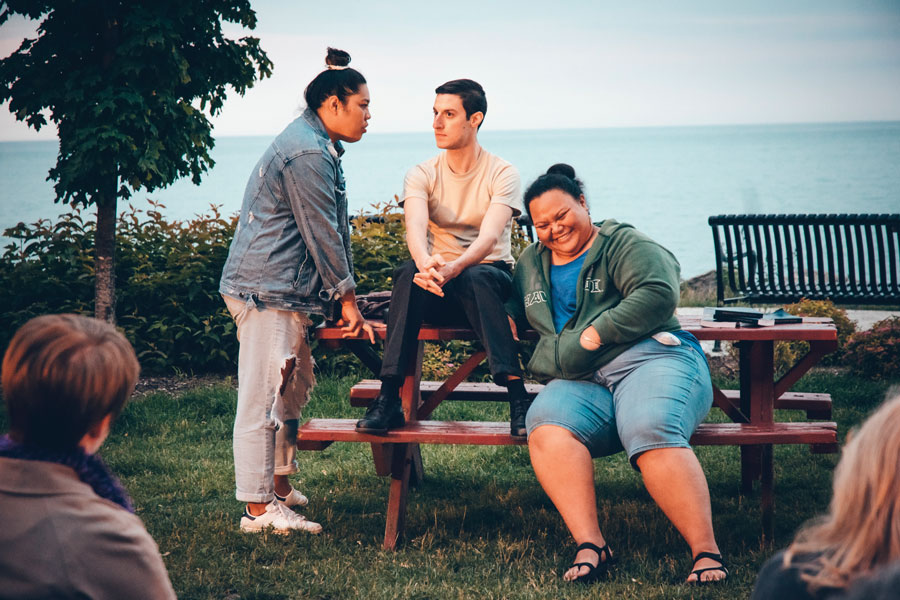Magic doesn’t have to cost millions. Throughout the country, small theatre companies build houses (and bodies of water), stage seven-hour Pulitzer-winning epics, and bring a bit of everyday Hawaii to the shores of Lake Michigan.
How do they do it? By seeing the potential in garages and horse stables, scavenging for foam and discarded motorcycles, and most significantly meeting their core audiences exactly where they’re at. The following companies’ fastidious planning, outside-the-box thinking, and emphasis on nurturing performers and designers alike might inspire even the wealthiest of Equity houses.
Midwestern Aloha
To tent or not to tent?
That was the question Nothing Without a Company (NWaC) faced last spring when staging the Chicago premiere of Not One Batu, an immersive look at Hawaii’s meth epidemic written by co-artistic director Hannah Ii-Epstein, who was born and raised on Oahu. (“Batu” is a Hawaiian Pidgin English term for methamphetamine.)
“Hannah really wanted to do it on a beach and I said, ‘Girl, that is not how Chicago works!’” explains Anna Rose Ii-Epstein, NWaC’s co-artistic director and Hannah’s wife. (The women combined two family names to form a portmanteau Anna calls “Jew-aiian.”) “We’d made a conscious decision to stay away from outdoor shows because of weather issues, so originally we were going to put up a $5,000 tent.”
Reclaimed spaces are the foundation of Nothing Without a Company, formed in 2005 by then-classmates at the Theatre School at DePaul University. The company’s annual budget is around $50,000, so site-specific work cuts cost on space rental, and makes for interesting artistic challenges. “The space tends to inform and challenge what the designers can do,” Hannah says. “For example, they can’t build a new doorway, but instead they have to make use of what the space provides.”
The play in fact began its life in Chicago, when Hannah, taking a playwriting elective at Columbia College Chicago in 2015, had an instructor who was also from Hawaii. “We started talking to each other in Hawaiian Pidgin English,” Hannah says, referring to the dialect that developed on sugar plantations and is now one of Hawaii’s official state languages. The instructor asked if Hannah would write a play in Pidgin, and Not One Batu was born.
The play premiered in Oahu in 2016 and won two awards from the Hawai’i State Theatre Council. Hannah and Anna wanted to bring the play to Chicago, since the city also has a meth problem. “The mainland has this postcard-presentation idea of what Hawaii is. I wanted to show people what the underground of Hawaii really felt like,” says Hannah, who herself has been in recovery from meth for over a decade.
Since Not One Batu only runs an hour, NWaC added an hour-long preshow for the audience “to meet the characters and immerse themselves in the language,” according to Hannah. To expand Chicagoans’ idea of Hawaiian culture, NWaC also invited the local Aloha Center Chicago to perform every night, and teach the audience to play ukulele or to hula.
Eventually, the Ii-Epsteins scrapped the tent idea (because it would have put them over budget) and staged Not One Batu on the lawn of Berger Park, a NWaC partner and Chicago Park District location. Despite paying the cast $200 each for the month-long run of the show (and an additional $125 the night the performance was filmed), and flying in actor Lelea’e “Buffy” Kahalepuna-Wong from the Hawaii production (a NWaC first), Not One Batu came in under its $15,000 budget, was extended, and exceeded its expected profits.
More importantly, the location was perfect. “We wanted to bring a little Hawaii to Chicago,” says Anna. “And the view of Lake Michigan made it feel like Hawaii.”
No tent necessary.
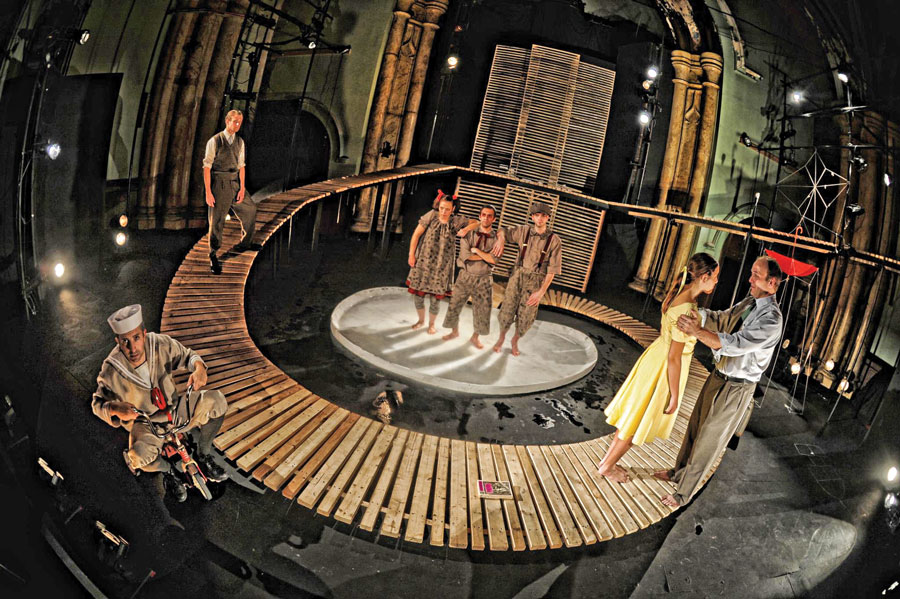
‘I Know a Guy’
In his three-decade-long career as a set designer and builder, Paul Kuhn has turned dumpster diving into an art form. “I’ve been diving in dumpsters since the ’80s,” says Kuhn, who is the founder, artistic director, and scenic designer for Curio Theatre Company in Philadelphia, whose annual budget is just under $118,000. For Curio he creates elaborate sets from found objects: entire houses for The Birds (budget: $9,500) and All My Sons ($14,600), Verona’s town square for Romeo and Juliet ($6,000).
Kuhn doesn’t just show up on a dark night unannounced; he’s made connections with various folks in the film industry. “I meet with studio heads [of a local film studio], and they just tell me flat out to take things or they’re literally going in the dumpster,” he says. “I saw a Harley-Davidson in there once.”
Kuhn’s brother-in-law also works for a New York-based film studio, and “he comes from Manhattan every Friday with a loaded truck for me,” Kuhn says. His yet-to-be-delivered wish list now includes “a beautiful fireplace, French doors, and stained glass with a Gothic arched window on top.”
Kuhn can also turn to Ken Opdenaker, a friend who owns the multimillion-dollar recycling and trash company RT Opdenaker & Sons. Unlike the film studios he works with, Opdenaker is, in Kuhn’s estimation, “a hoarder. If I call him and say I want a phone booth, he’ll say, ‘From what continent?’” He’s called on Opdenaker for more than three decades, ever since Kuhn was a young designer doing plays in a farmhouse.
Now that he’s older and running Curio with his wife, Gay Carducci, the company’s managing director, Kuhn hasn’t left his scrappy roots behind. The couple strives to “cast the audience” in each Curio production, he explains, rarely using the same seating arrangement twice in an effort to fully absorb spectators in the world of the play. “I like to put the audience where the walls are,” Kuhn says. “I like to make them the walls.”
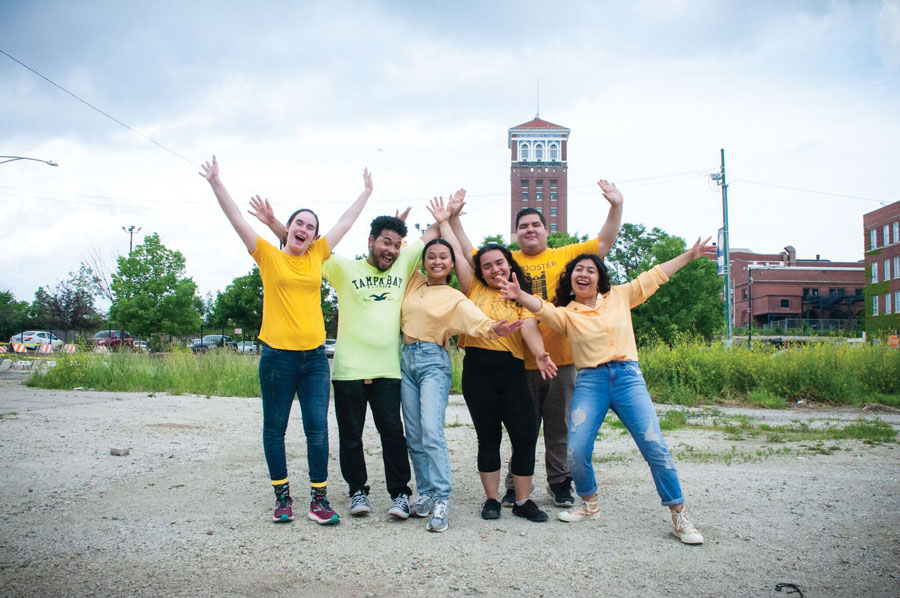
Converting the Masses
Sometimes, the secret to success lies in bad business.
“Our joke is that we have the worst business model in the world,” says Coya Paz, artistic director of Chicago’s Free Street Theater. “All our shows are free or pay-what-you-can, and we pay everyone who works with us.” It’s all in the service of Free Street’s mission, which is to bring art to the city’s underserved communities of color.
So how has Free Street thrived for 50 years? “We’re not performing in places with a lot of overhead,” Paz says. “We’re partners with the Chicago Park District. One of our spaces we get for free, and the other we get at a good price because we have a relationship with the family who owns the building.” Free Street also favors word of mouth over traditional marketing: “Our target audience is someone who didn’t know they were going to see a play.”
Last June, Free Street took guerrilla theatre to a whole new level. In honor of its 50th anniversary, the company mounted 50×50: a single day of pop-up performances in all 50 Chicago wards (districts). Naturally, the planning process was intense.
“We spent months making an epic spreadsheet of every ward in the city, and the churches, arts organizations, and stakeholders in every ward,” says Paz. Free Street hired 10 “lead artists” who created 20-minute shows, specific to and involving five to eight performers from each community.
Each piece reflected a Chicago ward in a unique format. “One was entirely in Morse code—we partnered with a tap dance company,” says Paz. “Another all took place on the [Chicago Transit Authority] Red Line train.”
Even root vegetables joined the party. “In one group, the whole ensemble was people from immigrant backgrounds who looked at recipes,” explains Paz. The show’s prompt was, “What would you do with a yam,” because, according to Paz, the vegetable “shows up in a lot of different cultures.”
Paz estimates that Free Street spent under $30,000 of its $356,000 annual budget that day, and “almost all of it” went to paying the 100 people who worked or performed. Counting those who livestreamed the performances, Paz estimates the audience numbered around 1,500. “We performed in farmer’s markets, on street corners, and where Laquan McDonald was killed,” she says. “When you give artists an opportunity that has both very specific restrictions and endless possibilities, they really will make an amazing range of work.”
The performers, who ranged from 5 to 70, were a mix of Equity and non-Equity (though everyone was paid the same). “In a city like Chicago, our storefront theatre ecology is driven by people who primarily pay their rent with day jobs,” says Paz. “Many of our artists have trained formally, many have not trained formally but are seeking careers in the arts, and many have honed their performance skills through a different pipeline, like church pulpits and city porches.”
Moreover, the event encapsulated Free Street’s mission of arts accessibility for all Chicagoans. “Our motto is ‘theatre for people who hate theatre,’” says Paz. For her, 50×50 proved that artists shouldn’t just expect audiences to come to them; they need to go out to where their audiences are. “Arts advocates love to talk about the power of the arts dollar, but that only works if we’re spending money in your community.”
Make Yourself at Home
Preaching diversity is one thing, practicing quite another. Jon Tracy is only interested in practice.
When the then-freelance director took the helm of TheatreFirst in 2016, the 20-year-old company was producing established works like Glengarry Glen Ross. Like most theatres in Berkeley, Calif., its audience was primarily white. When Tracy arrived, he and the company decided: “Let’s not reflect the community that we have. Let’s create the community we want.”
So Tracy and company bade Glengarry and the like goodbye. In 2016, TheatreFirst switched to producing only new work with playwrights actively involved throughout the process, and in the process tackled a wide array of contemporary topics like human trafficking, intersectional feminism, and the life of Henrietta Lacks.
The company also committed to ensuring that every part of TheatreFirst, from creative teams to board, would comprise of at least 50 percent women, two-thirds people of color, and one-third LGBTQ+ identified. For Tracy, creating that community also involved fair compensation. TheatreFirst’s production and creative teams earn the Berkeley minimum wage: $15.59 an hour. Actors receive the same rate, starting with callbacks.
“Actors are coming into a space to work with the playwright and director, and should be paid for that work,” Tracy says. These rates are built into TheatreFirst’s Actor Bill of Rights, which takes a holistic approach to caring for performers. “There will always be food—not snacks, but a full table of nourishment when actors arrive at the theatre.”
Self-care is also a priority. Thanks to TheatreFirst’s Lights Up project, actors who are responsible for child or elder care can be paid up to an additional $2,000 to offset those costs.
How do they manage all this on a $320,000 annual budget? According to Tracy, a curated combination of government, foundation, and community funding. “By breaking up the funding into three categories, we were able to build in a system of faith,” he says. “When talking to a skeptical government funder, we could point to the funding strength of the foundations and community. When talking to foundations, we could point to the strength of community and government support.” In fact, a recent crowd-funding campaign netted more than $37,000 from 268 community members.
This year TheatreFirst will feature new work involving ghost stories, queer voices, and #MeToo. Four and a half years into his tenure, Tracy has found that actively diversifying—from board to audience—leads to deeper work. “When you have that ensemble of human beings, and you match that with practical rules with which to engage in communication, and a deep understanding of the nature of implementing ideas,” Tracy says, “you can do some really cool shit.”
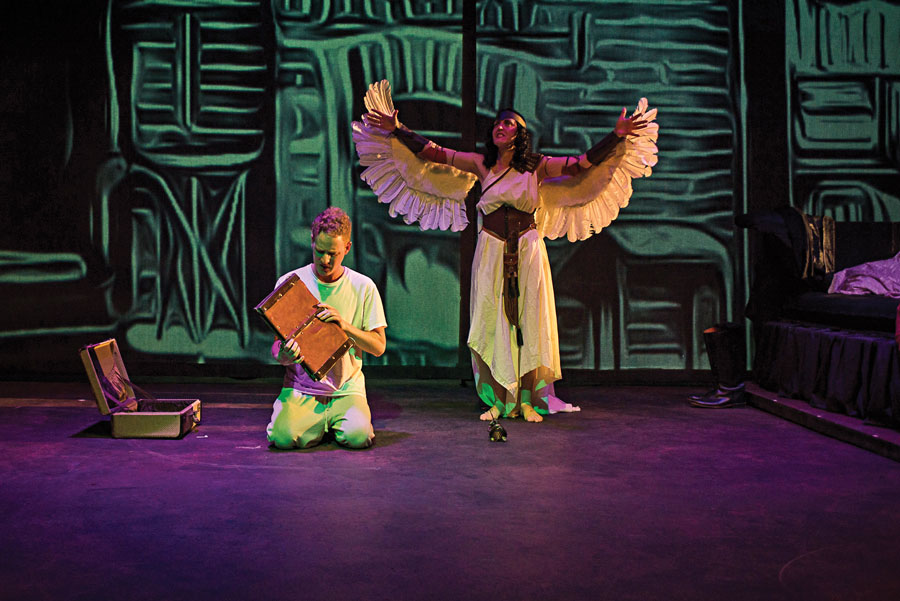
Classics, Meet Comics
Some mothers pass down jewelry. Celeste Cosentino’s passed down a theatre company.
Growing up in Cleveland, Cosentino learned at the feet of her mother Lucia Columbi, who founded the local Ensemble Theatre in 1979, a few months after Cosentino was born. Cosentino would eventually inherit her mother’s theatre; she’s been executive artistic director of Ensemble Theatre for nine years.
In that time, she’s enhanced Ensemble’s initial mission: classical and significant modern plays with non-traditional casting. “In the early ’80s, my mom cast a young Black actor as Thoreau,” says Cosentino. “She wanted to reach out to people’s cultural backgrounds. Now I’ve expanded to include gender roles and identities.” Ensemble’s forthcoming season will include the musical Fun Home, Lynn Nottage’s Intimate Apparel, and Margaret Atwood’s The Penelopiad.
“Shows that little theatres would shy away from, we do on purpose,” says Cosentino. Last year the centerpiece show was Angels in America, Tony Kushner’s seven-hour magnum opus with scenes set on Earth and in heaven. It was no small feat, considering Ensemble’s annual budget was between $125,000 and $130,000 and that season included four other productions. So how did director Cosentino pull off seven hours, 26 locations, and a plethora of scene changes?
“We did Angels in America as a graphic novel,” she explains. With the help of a savvy design team, Ensemble projected images “Photoshopped to look like an abstract, stylized version of each locale.”
Cosentino used four large screens as both backdrops and curtains, allowing for smooth transitions rather than blackouts. “People crossed into each other’s worlds and pushed boundaries,” she says. “If one scene was happening and another was existing at the same time, those actors stayed onstage.” In one particularly powerful scene, Louis and Joe were face to face onstage, existing in the same time but in different spaces.
As for the Angel’s entrance at the end of Part One, crashing through Prior Walter’s bedroom ceiling, Cosentino found an ingenious solution. “The screens opened up and the Angel was harnessed,” she says. “We had an [aerialist] in our Great Gatsby, and she came back to help us. For Part Two, we had two [Angel] entrances that were behind the audience, up in the air.” Ensemble invested in moving lights for Part Two, so “Harper’s final monologue was in the audience. The audience was on the plane with her, and the screens became the view outside the plane.”
It didn’t hurt that Ensemble split up Angels, with Part One presented in January and Part Two in April, with an entirely Cleveland-based cast. (Only one performer had to be replaced, due to the original actor booking a film.) Thanks to $3,000-$5,000 of in-kind design services, each part was produced for less than $30,000.
Cosentino says that Ensemble will continue producing grand shows, but with a bit more money to play with. Thanks to two individual donations, Ensemble’s current budget is now approximately $225,000—and Cosentino, who initially didn’t draw a salary so she could pay artists, no longer has to work a corporate day job. “Now I can actually get paid and pay everyone else,” she says. “It’s great!”
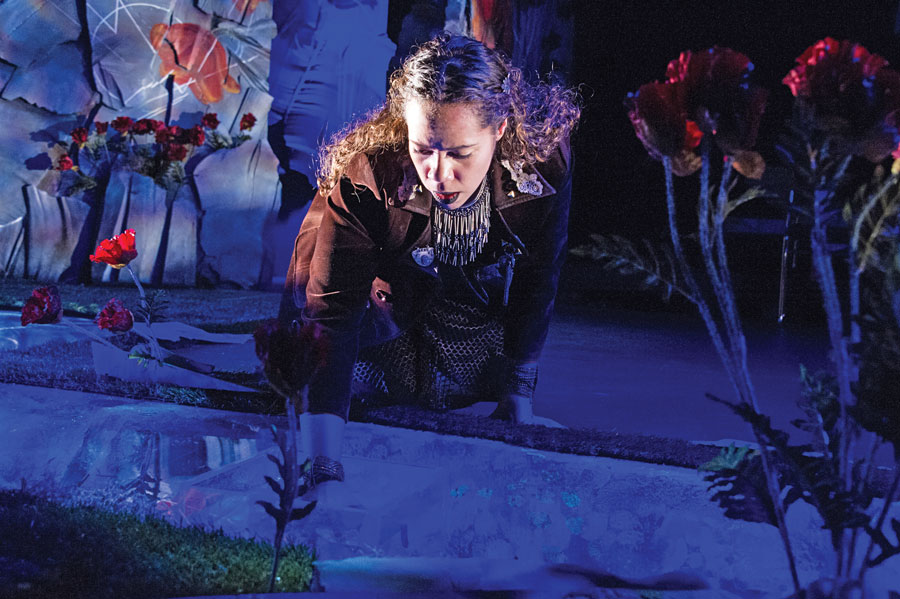
The Shape of Water
Magical realism can come cheap: Just ask Rorschach Theatre. Better yet, ask them about the river.
“We wanted to surround the audience with the experience of the play,” says Jenny McConnell Frederick, co-artistic director of the Washington, D.C., company and director of last year’s Sing to Me Now, a new dark comedy about what happens when the overwhelmed muse of epic poetry hires a human intern to help save the world. “The main character collects ideas and dreams from a river. You couldn’t do the play without it, right?” Right, but how do you do it and stay within the play’s $45,000 budget?
Frederick, who directed, didn’t want to use fabric and lighting. “I wanted the actors to be wet,” she says. Creating a river, then, took quite a bit of engineering ingenuity.
First they elevated the theatre’s floor by eight inches. (Rorschach, with an annual budget of $200,000 to $225,000, makes its home in a black box space at the Atlas Performing Arts Center.) They then carved a river out of foam, left over from an exhibit at the National Building Museum, and filled it with real water, covering certain areas with plexiglass to prevent leakage, while leaving others open so actors could get their hands and arms wet. (One actor had to be soaked head to toe, which she accomplished by submerging into an 18-inch-deep pool backstage.) They also ran lights through the entire structure. The results were low-cost but looked like a million bucks.
“We’re in a traditional space, but we’re using it in a non-traditional way,” says Rorschach’s artistic director, Randy Baker. But that’s par for the course with the company’s mission: “We’re attracted to impossible theatre—if it’s impossible on a big budget, it’s not that much more impossible on a small budget. Impossible theatre inspires impossible creativity.”
Lauren Emily Whalen is a 2018 alum of the O’Neill Theater Center’s National Critics Institute, an Equity Membership Candidate, and author. She lives in Chicago, on a budget.

